If you’re looking for a playful, hearty, and beautiful fish for your aquarium, look no further than the South American Cichlid. This breed comes in a wide variety of color patterns and sizes making them ideal for almost any tank size or decor. Their playful attitude makes them a fan favorite for beginners and experts alike. Let’s take a closer look at the South American Cichlid to see what makes them so great.
Table of Contents
South American Cichlids Overview
Cichlids are among the most sought-after fish in the aquarium hobby today. They are recognized for their great diversity of colors, shapes, sizes, and personalities. With ranging from 2,000 to 3,000 species currently known, there’s a cichlid out there for everyone.
| Information Chart | South American Cichlids |
| Scientific Name: | Microgeophagus ramirezi |
| Family: | Cichlidae |
| Care Level: | Intermediate |
| Temperament: | Aggressive |
| Color: | Various |
| Lifespan: | Up to 20 years |
| Size: | 3–15 inches |
| Diet: | Species dependent |
| Minimum Tank Size: | 30 gallons |
| Temperature: | 20-24° |
| Water
Conditions: |
|
| Tank Mate Compatibility | Species dependent |
Availability
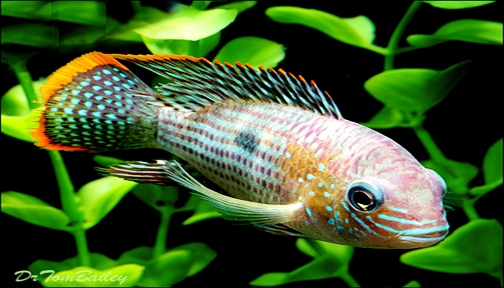
The Cichlid is truly a citizen of the world. They can be found in Asia, Africa, North America, and, obviously, South America. The flagship or type specimen for the breed is the South American cichlid, Cichla ocellaris. Quite a mouthful! A friendlier, and more common, name is the Peacock Bass or Peacock Cichlid. While all cichlids are part of the same (large) family, the South American cichlids are colloquially known as the poster child for the breed.
Species Development
North and South American cichlids have evolved in a similar fashion to the African varieties, albeit with less radical speciation. American Cichlids are known to be the first fish species to populate the freshwater basin in Central America. South American cichlids were the dominant variety throughout the Americas. Being at the top has its advantages as the South American variety developed some distinct specializations, similar to their African counterparts. One notable example is the disk-shaped body of the aptly named Discus and the popular Angelfish.
South American Cichlids Appearance
To no one’s surprise, cichlids are among the most colorful and aesthetically beautiful fish in the fishkeeping world, and they are also among the most popular.
Varieties of South American Cichlids
A total of about 150 species of South American dwarf cichlids are known to exist, all of which are readily managed and produced in an aquarium environment. Aside from that, several species have produced cultivated varieties that you can only find in captivity.
- Dwarf South American Cichlid: Cockatoo, Ram Cichlids, Rainbow Cichlids
- Giant South American Cichlids: Blue Acaras, Severum
Speciation
The fish can be subdivided into three main groups: Dwarf American Cichlids, Large American Cichlids, and a group that does not fit into either of the two previous groups (mostly for hybrids, but also for the previously mentioned Discus and Angelfish). Let’s take a closer look at each group.
Dwarf American Cichlids
Most of the smaller cichlids are found in the dwarf group. Quite a few never get any larger than 4 inches (or 10cm) and could have plenty of room in a 20-gallon tank. Included in this group are colorful varieties such as the American Dwarf Cichlid or the shy New World Dwarf Cichlid. Both of these examples lean more to the delicate side of things so they would probably not be ideal for a beginner aquarium owner.
Large American Cichlids
On the opposite end of the spectrum you’ll find the large American cichlids. Their larger relatives require more space, which is why experts suggest a 75-gallon tank minimum. Surprisingly to some not familiar with cichlids, these can actually develop something of a personality and have even been known to develop a bond with their owners. Colorful markings and great temperaments make them an aquarium favorite.
And the rest…
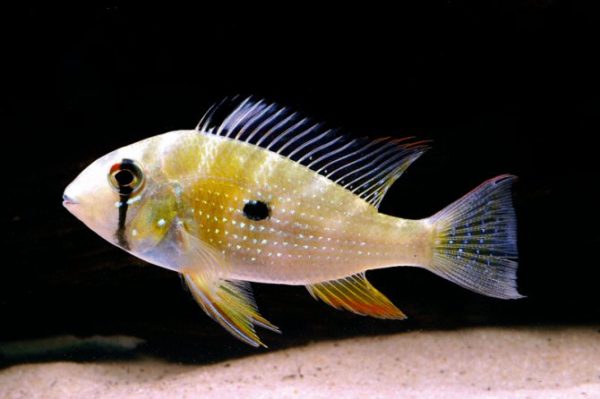
The last group, which contains hybrid cichlids, discus, and angelfish, is hard to name since the members are so varied. Some notable hybrids include the Flowerhorn and the Blood Parrot Cichlid, both of which have interesting body shapes and majestic coloring. The Angelfish has translucent fins that look like angel wings and the Discus has a large, round, disc-shaped body, hence the names of these two. You can see why classifying these varied fish is no easy task, which explains why it is a group without a proper name.
The Lifespan Of South American Cichlids
Dwarf Cichlids, sometimes known as butterfly cichlids, are tiny fishes that live for less than a year. The other species begin to exhibit their age after around three years of life. None of the species are expected to live more than a year in the wild.
South American Cichlids Size
Initially, South American dwarf cichlids grow fast and usually are sexually active at six months at the earliest. At this point, they will be 1/3 to 1/2 of their probable final size.
Like other fishes, South American dwarf cichlids may continue growing throughout their lifespan. In all species, males grow larger than females.
No species grows longer than 10 cm, and the majority remain much smaller throughout their lifetimes.
Natural Habitat and Origin
Keeping them in a cichlid-only aquarium is advisable since they consume tiny fish to fit in their jaws.
There are various types of South American cichlids available to suit your needs. Whether you’re seeking colorful, tranquil fish with plenty of personalities to add to your community tank, magnificent showpieces that will make others envy, or giant specimens that can be hand-fed and trained to do tricks, you’ll find all of them.
South America is home to the Amazon River, which, at just over 4,000 miles long is the world’s second longest river stretching from the Andes Mountains in Peru all the way down into the Atlantic Ocean. That much water is naturally going to attract some fish, which explains why over 2,000 species call the Amazon their home. In fact, 20% of the world’s freshwater is contained within the Amazon, making it the obvious choice for freshwater fish species. You may have read about the importance of substrates in freshwater aquariums and you can thank the Amazon for that trend. The river has a muddy sand mixture that allows for a wide variety of plants to grow, providing a wealth of food for fish.
South American Cichlids Care & Tank Set-Up
The number of cichlids you have and their size when they reach adulthood will determine the bare minimum size of your aquarium. Cichlids smaller than 6 inches (15 cm) in length need at least a 20-gallon tank. Cichlids up to 8 inches (20 cm) in length need a minimum of a 29-gallon aquarium.
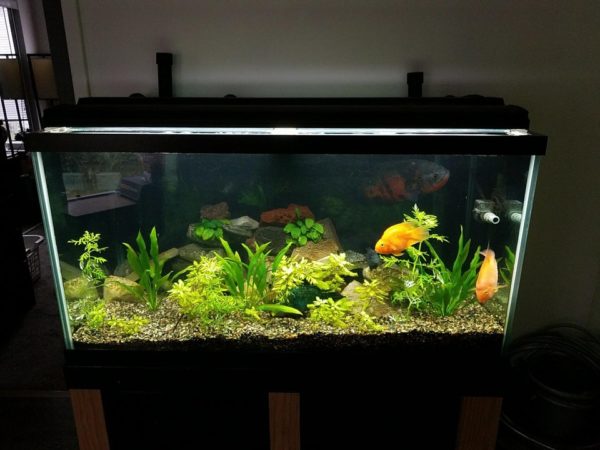
Because they are a miniature cichlid species, you will only want a minimum of 20 gallons (75 liters) of tank space to maintain a single pair of them in good health. However, as is typically the case, more significant is always preferable. If you want to keep German blue rams in good health, the best aquarium size would probably be at least 30 gallons, mainly if you’re keeping them in a community tank with other species.
On the other hand, the Rams are well-known for being generally tranquil inside their tribes. They are thus often regarded as an excellent option for folks who are just starting with South American cichlids.
South American Cichlids Tank Size and Specifications
The minimum size of your aquarium is determined by the number of cichlids you have and their adult size. Cichlids with a length of fewer than 6 inches (15 cm) need a tank of at least 20 gallons. Cichlids up to 8 inches (20 cm) in length need a tank of at least 29 gallons.
Optimum Tank Size for South American Cichlids
20-29 gallons
Filter Type
An aquarium filter should process all of the water in the tank 3 to 5 times each hour. For example, a filter in a 20-gallon tank would need to transfer at least 60 gallons of water each hour. Follow the manufacturer’s instructions for selecting and installing the filter.
Substrate
Add beneficial bacteria supplements to the water to enhance biological waste breakdown while introducing fish.
The chemical balance in your aquarium will shift with every new fish you add, so check the water’s pH, ammonia, nitrite, and nitrate levels periodically.
How many South American Cichlids are in 20-gallon tank
5
Water Parameters for South American Cichlids
Maintain a healthy habitat for your fish with periodic water testing and change 10 percent of the water weekly or 25 percent monthly. Refill with de-chlorinated water.
Water Temperature
Their ideal water temperature is approximately the mid-70s (around 24 °C); however, they can endure warmer temperatures if they have to.
pH Level
7.0 to 8.0
South American Cichlids Tank Landscape
This acrylic aquarium is 17 times stronger and weighs half as much compared to glass. The average-sized cichlid would fit right in here. Cichlids are, without a doubt, among the most popular freshwater fish species. They’re well-known for their gorgeous looks, unusual habits, and upbeat dispositions.
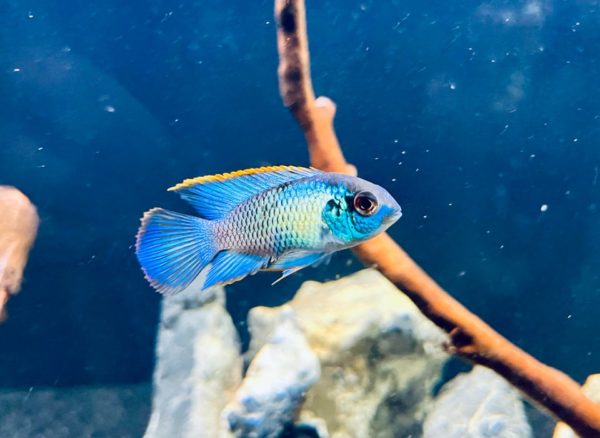
In the Cichlidae family, there are roughly 3000 species, and these fish are part of it.
Cichlids come in many shapes and sizes, from the small Neolamprologus multifasciatus (less than an inch long) to the Giant cichlid (more than three feet long). They also have a wide variety of body forms, ranging from cylindrical and elongated to horizontally flat.
Best Plants for South American Cichlids Tanks
Echinodorus. Discus, as well as South American tanks, are best suited for broadleaved Amazon Sword Plants. Nonetheless, they may be kept in an aquarium alongside other cichlids if they are kept within specified parameters. To thrive, this plant requires an abundance of nutrient-rich soil.
Worst Plants for South American Cichlids Tanks
Java moss, Anacharis, Anubias, Hornwort, and Green Cabomba are just a few species. Because of their bitter flavor, these plants are not appealing to African cichlids. The African cichlids would not be able to uproot these plants if you kept them floating or attached to decoration in your tank.
Decorations For South American Cichlids Tanks
Decorate with plants, rocks, and fish. Because cichlids are territorial, ensure there is enough furniture for each fish to have its domain. Cichlids prefer hiding, so they put a few cave forms in the tank. Before putting anything in the tank, make sure it’s clean. Finish by filling the tank with water to the top and covering it with a lit canopy.
Lighting for South American Cichlids Tanks
Experts recommend using fluorescent tubes instead of incandescent bulbs while caring for animals. These emit light instead of heat, which helps maintain a steady temperature in the water. If all these lights are left on for at least eight hours a day, they will encourage plant development, specifically the growth of algae, which is an essential source of food for many cichlids in the aquarium. You are advised to update the lights at least once a year, though.
If the light production decreases, it will affect all of the life within the tank. The natural environment of your cichlids will determine the brightness of these tubes. For instance, the cichlids from Lake are more used to murkier water than the cichlids from other bodies of water. If you cannot modify your lighting to an acceptable level, floating plants, including such duckweed, can be used to soften the light.
Nitrogen/Other Nutrient Requirements For South American Cichlids Tank?
Cichlids are a family of fish that includes more than a hundred distinct fish species. They are among the most vibrant species that we find in freshwater aquariums, and they have a wide range of colors. The degree of care that they need varies from one cichlid species to the next. Most of these fish will require plant materials and algae since they have specific diets. It is possible to produce ammonia when there is fish excrement present. If the concentration of this substance is more significant than 0.25 particles per million, it is very hazardous. The safe amount is between 0 and 0.25 particles per million particles. As Nitrobactors (nitrate-forming bacteria) grow in number, they reduce the amounts of nitrite in the environment while increasing nitrate levels.
Throughout this cycle of ammonia and nitrite being transformed into nitrate, billions of tiny bacteria are produced, contributing to your aquarium’s cleanliness and stability. However, nitrate build-up does occur occasionally, and you must keep it to fewer than 20 particles per million at all times.
Feeding South American Cichlids
Most Central American & South American cichlids are selective carnivores or piscivores (fish eaters), consuming bug larvae, worms, and small fishes in the wild. Some species also consume mollusks, plankton, and plant stuff. They may be given a variety of diets, including live foods, frozen & prepared foods, algae, flakes, and pelleted feeds
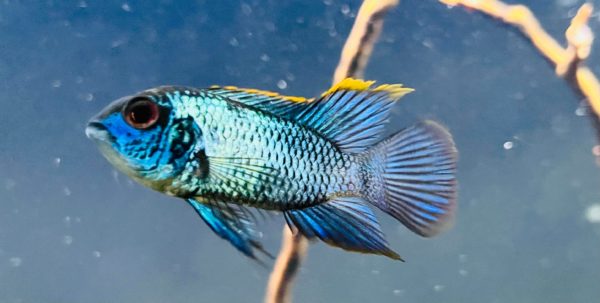
Best Diet for South American Cichlids
Typically, premium, complete nutrition, color-enhancing, gold formula, and other designations will be applied to cichlid flakes and pellets. In principle, this all sounds fantastic, but in practice, they are simply marketing ploys designed to trick you into believing that you are utilizing a high-quality product.
Food for cichlids that comes in pellets or flake form is frequently loaded with various plants and plant proteins that provide little nutritional benefit if any.
How Often Should You Feed South American Cichlids?
Adult cichlids must be fed three to four times each day, with an amount they can swallow in less than 30 seconds each time. This feeding approach helps to reduce a child’s tendency to become aggressive while competing for food. The fish are also voracious (borderline annoying) eaters, meaning they may swallow a significant amount of food in as little as half a minute or less.
South American Cichlids Behavior And Temperament
South American cichlids are by far the most peaceful members of the genus Cichlidae. They are not as aggressive or competitive as the Central American and African cichlids, which are more aggressive and combative. Their calm temperament makes them excellent members of most community tanks due to their calm temperament.
Are South American Cichlids Lone Or Societal In Nature?
Cichlids are known for their vibrant colors and patterns. Aside from that, they’re highly energetic and gregarious, and they exhibit several unusual habits, particularly during mating. Those who choose to retain any of these animals will not be dissatisfied.
South American Cichlids Tank Mates
Cichlids that are not aggressive are common, such as the Bolivian Ram, Blue Acara, Keyhole, the electric yellow African, and Peacock. When it comes to living in groups, cichlids are the most significant cichlids to have since they allow the other fishes to dwell in their area rather than bullying and exhibiting territorial traits.
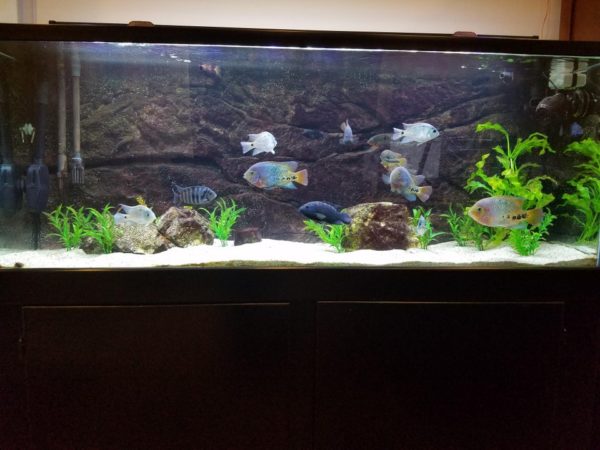
Ideal South American Cichlids Tank Mates
Adding dither fish species to aquariums holding aggressive Cichlids is critical for their wellbeing. Alongside its ability to move quickly, the Mexican Tetra is an excellent dither fish for keeping with Central American Cichlids in a community aquarium. The Rainbowfish would make an excellent dither fish for African Cichlids as a buddy fish.
Bad Tank Mates For South American Cichlids
Cichlids are not alike when it concerns tank mates, which is especially true for breeding. The first thing to note is that some are aggressive, while others are not. The majority of African and Central American Cichlids are generally aggressive in temperament, and as a result, they should not be housed in the same tank together.
Breeding
According to cichlid classification, mouth and substrate brooders are the most common. They are either monogamists or polygamists. There are exceptions, like the most cichlids of Lake Malawi, which are monogamous mouth breeders. The pathos, chromidotilapia, and gymnogeophagus cichlids fall under this category.
South American Cichlids Breeding Level
All cichlids become aggressive and protective of their home ranges during the breeding season. Before reproducing, they perform complex courting rituals that include recognition indicators such as color exposition and other displays of emotion. In addition to mouthbrooders, several cichlid species spawn on the ground.
South American Cichlids Sexual Dimorphism?
In cichlid species, color differences across sexes are presumably the result of distinct selection regimes operating on each one. Color polymorphisms, which are connected to sex, have been widely considered to have alleviated this conflict.
South American Cichlids Common Diseases And Their Treatment
Swim Bladder Disease
Swim bladder illness impacts the cichlid’s swim bladder. Swimming is made possible by the swim bladder, and an abdominal sac lined to the epithelium that aids fish in maintaining their buoyancy while underwater. Cichlids infected with swim bladder illness have a hard time remaining underwater. Some secondary disorders, such as cancer and TB, can cause the swim bladder to malfunction.
Another principal reason is that swim bladder illness is more prone to occur in skeletal or constipated fish. You must address the fundamental source of the problem to treat this disease. Constipation can be alleviated by providing high-fiber meals like peas and spinach to fish with a poor diet.
Facts about South American Cichlids
Cichlids are not alike when it concerns tank mates, which is especially true for breeding. The first thing to note is that some are aggressive, while others are not. The majority of African and Central American Cichlids are generally aggressive in temperament, and as a result, they should not be housed in the same tank together.
Are South American Cichlids Right For You?
When selecting fish for such a community tank, you must consider both the size of the tank and the species of fish that will be kept in it. It’s important to remember that many cichlids grow to be somewhat massive fish while setting up your aquarium. When it comes to preserving the peace in your community tank, choosing non-aggressive species is the best alternative. However, you may still have issues with territorial behavior and bullying from time to time.
General Tips
In closing, make sure you perform all the basic fish care tasks for your South American Cichlids. This includes routine water change outs, regular feedings and a strict adherence to a regulated temperature. As far as food goes, most cichlids are carnivorous, consuming smaller fish, insects, and worms in their natural environment. For your tank, consider any of those options, but for the less adventurous owner, they are also fine with traditional flakes or pellets. Remember to take care of your South American Cichlid and they will provide you with years of entertainment and companionship.
FAQ
Are Cichlids Native To The South American Hemisphere Allowed In My Home Aquarium?
As long as you mix species that generally coexist in the wild and are generally medium to big, you can quickly attain this goal. Serums, Satanoperca, chocolate cichlids, angelfish, Uaru, and sometimes even wild Discus may be kept together in a tank as large as 1.8 meters (6 feet) or more. If you’re looking for peaceful companions, Acarichthys heckelii, as well as Biotodoma Cupido, is ideal.
Is It Possible For Me To Smother Them Like The Malawians?
Even if it is technically conceivable, it is not how fish want to live, and they will all end up appearing dog-eared and washed out instead of majestic with flowing fins and extensions of the tail.
If provided too much room, Malawi cichlids are reported to become aggressive and challenging to coexist with. Cichlids from South America will get along better and even reproduce if they have more room to roam.
Where Do Cichlids From South America Get Their Warm, Soft Water?
Quite the contrary, cichlids known as Geophagus brasiliensis, the Pearl Cichlid (Geophagus brasiliensis) is native to the country’s east coast and is found in both fresh and saltwater. Among other things, the hump-headed Gymnogeophagus species prefers cold, practically temperate water conditions.
Do your study already when you buy, because even an Apistogramma doesn’t enjoy it when it’s too hot. Also, don’t automatically assume that fish from South America or the Amazon will be in acidic black water.
Conclusion
About 150 South American dwarf cichlids are easily managed and produced in an aquarium environment. Aside from that, several species have produced cultivated varieties that you can only find in captivity. Although they belong to the same species, these cultivated versions of the Butterfly Dwarf Cichlid differ from their native or wild counterparts, largely in coloration. Several generations down the lane, you’ll observe many such counter-bred offsprings in freshwater aquariums.
No related posts.
